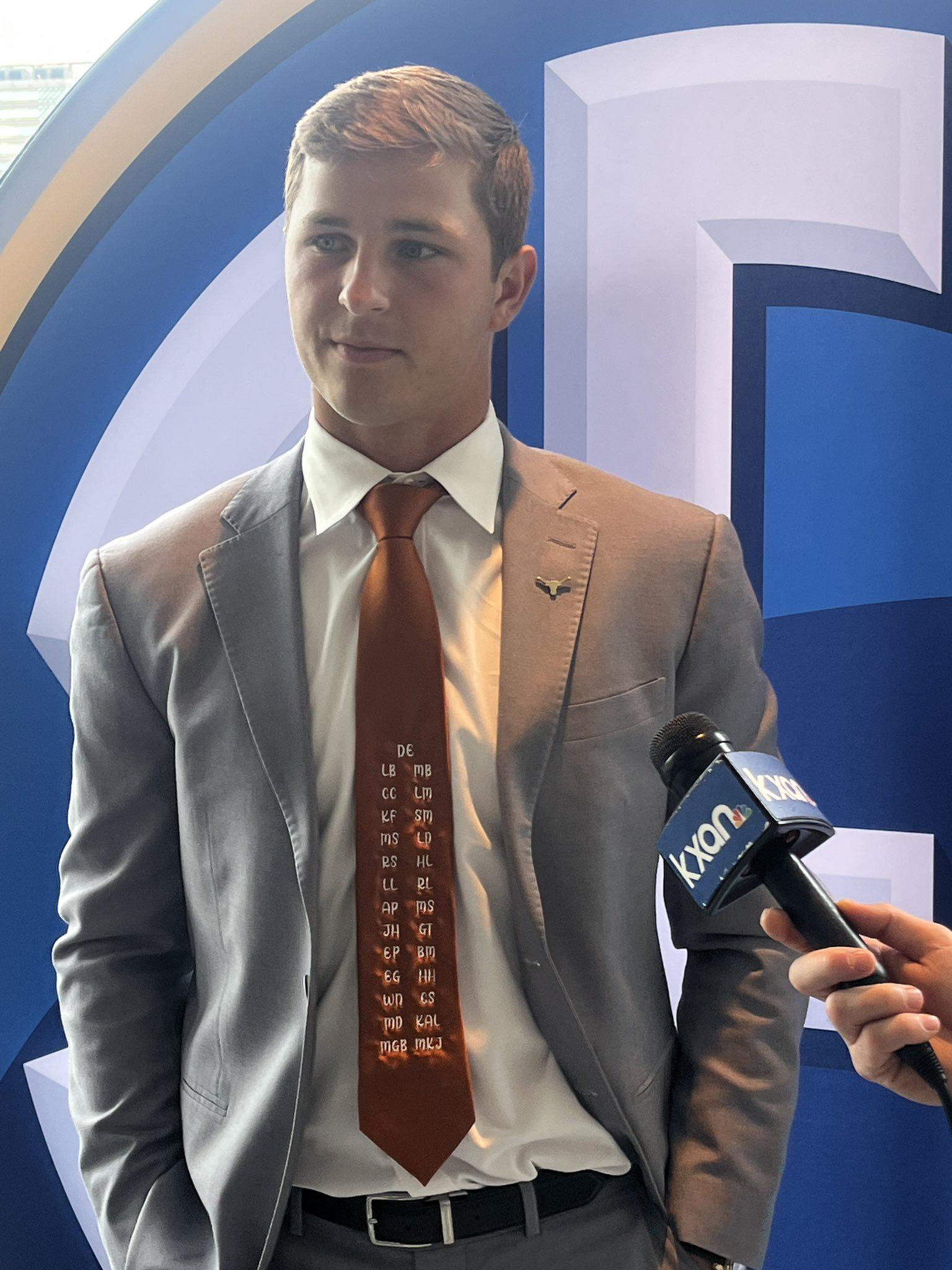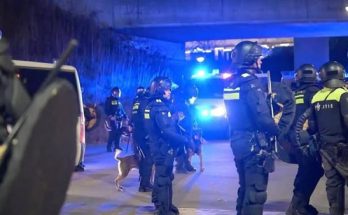When Texas defensive back Michael Taaffe arrived at the SEC Media Days, his appearance was striking—not just because of his stature or the intensity he brought to the podium, but because of the tie he wore. Unlike the typical vibrant or logo-emblazoned ties commonly worn at such events, Taaffe’s tie was somber, understated, and deeply meaningful. It bore the initials of every victim who had tragically lost their life in the recent Kerr County floods, a disaster that had forever altered the lives of many in that tight-knit community, especially the beloved Camp Mystic.
The tie was more than just fabric and thread; it was a symbol of remembrance, resilience, and respect. Each initial stitched carefully along its length represented a person—a life cut short, a story left unfinished, a light extinguished too soon. For Taaffe, this was not merely a gesture of solidarity but a personal mission, a call to keep these memories alive amid the flood of headlines and the passage of time.
Kerr County, nestled in the heart of Texas Hill Country, is a place known for its rugged beauty and close community ties. When the catastrophic floods hit, the devastation was swift and unrelenting. What began as heavy rainfall quickly transformed into raging waters that swept through towns, homes, and the beloved Camp Mystic, a summer camp cherished by generations. The camp, a sanctuary for children and families to connect with nature, learn new skills, and build lifelong friendships, became the epicenter of a tragedy that shocked the entire state.
The community’s grief was palpable. News reports detailed the damage and the rescue efforts, but the personal stories of loss were what truly resonated. Families mourned children who had been excited to start their summer at Camp Mystic. Friends remembered the laughter and joy that now felt like echoes from a distant past. For many, the flood wasn’t just a natural disaster—it was a wound in the fabric of their lives.
Michael Taaffe, a proud Texas Longhorn, had grown up hearing stories about Camp Mystic from his family. Though he hadn’t attended the camp himself, he understood its importance in the community and the heartbreak caused by the flood. As a public figure and role model, he felt compelled to do more than just voice sympathy. Wearing the tie was his way of carrying the memory of the victims with him, making a visible statement that would prompt conversation, reflection, and hopefully, healing.
The tie’s design was simple yet powerful. Against a dark background, the initials of each victim were embroidered in a subtle, respectful font. It was not meant to be a spectacle but a solemn tribute. Each letter stood for a person’s name, their identity preserved in a form that would travel with Taaffe wherever he went during the media event. For those who recognized the initials, it was a moment of connection. For others, it was a prompt to ask, to learn, and to remember.
During the media sessions, questions about the tie inevitably came up. Taaffe spoke with calm conviction about the significance of the floods and the lives lost. He emphasized that sports, while a platform for competition and entertainment, also carries responsibility—a responsibility to use visibility for causes greater than oneself. He hoped that by bringing attention to the tragedy, he could honor the victims in a way that extended beyond the confines of the local community.
He reflected on the symbolism of the tie as a medium. In many cultures, ties represent professionalism, unity, and sometimes, mourning. By incorporating the initials of the Camp Mystic victims, the tie became a wearable memorial. It was a quiet, dignified way to remind people of loss and the necessity of empathy, even in spaces focused on sports and media spectacle.
Taaffe’s gesture also spoke to the power of remembrance. In a world that often moves too quickly, tragedies can become mere statistics, quickly forgotten as the news cycle turns. But when a person chooses to carry a memory physically, it disrupts the flow, demanding attention and respect. The initials on his tie were a refusal to let these lives be erased by time.
The story of the Kerr County floods and Camp Mystic victims was not just about loss—it was also about community strength and healing. Taaffe’s tie reminded people of the collective responsibility to support one another in the aftermath of tragedy. It was a call to action, urging those with the means and influence to contribute to recovery efforts, whether through donations, volunteering, or simply spreading awareness.
As Taaffe navigated the intense environment of SEC Media Days, he knew that many attendees might not fully grasp the depth of the flood’s impact. Yet the tie’s presence forced a pause—a moment to acknowledge the gravity behind the initials. It humanized the statistics, giving faces and stories to a calamity that otherwise might be reduced to a headline.
Beyond the media event, the tie became a symbol back home in Texas. People who had lost loved ones saw it as a sign that their grief was shared and honored beyond their immediate community. It fostered a sense of solidarity and reminded survivors that they were not alone in their pain. For younger fans and aspiring athletes, Taaffe’s choice illustrated how one could use their platform for meaningful causes, blending athletic ambition with social consciousness.
The story behind the tie spread through social media, news outlets, and word of mouth. Fans and fellow athletes praised Taaffe’s thoughtful tribute, recognizing that such acts, while small in appearance, carry significant emotional weight. It encouraged others to find their own ways to remember and advocate, reinforcing the idea that remembrance is an active process, not a passive one.
The Kerr County floods had exposed vulnerabilities—not just in infrastructure and emergency response but also in the way society cares for its most vulnerable during crises. Taaffe’s tie was a reminder that beyond policy discussions and aid packages, at the heart of every disaster are individuals and families whose lives are forever altered. Each initial was a testament to a life valued and a future lost, urging ongoing attention and compassion.
Michael Taaffe’s presence at SEC Media Days wearing that tie was an embodiment of how athletes today are becoming more than just performers on a field. They are voices for change, bridges between communities, and bearers of memory. His simple yet profound choice underscored how personal loss and public identity can intersect, creating moments that transcend sport and resonate deeply with human experience.
In the days following the media event, the conversation sparked by Taaffe’s tie continued to unfold. Local organizations in Kerr County saw increased support as people across Texas and beyond reached out to offer help. Conversations about climate resilience, disaster preparedness, and community rebuilding took on new urgency, fueled by the renewed awareness Taaffe’s tribute helped generate.
For Taaffe himself, the tie was a reminder of purpose. As he prepared for the upcoming football season, he carried with him not just the physical reminder of the victims but the emotional commitment to honor their memory through his actions—on the field, in the community, and in every platform where his voice could make a difference.
The Camp Mystic flood victims’ initials on that tie were more than just letters. They were stories of childhood dreams, family bonds, and the fragility of life. They challenged everyone who saw them to remember, reflect, and respond with empathy. In that way, Michael Taaffe’s gesture was a beacon—a call to hold tight to the past, confront the present with courage, and build a future where such tragedies are met with unwavering support and remembrance.
The legacy of the Kerr County floods and Camp Mystic victims thus found a powerful advocate in Michael Taaffe. His tie at SEC Media Days was a thread connecting grief and hope, loss and action. It was a reminder that even in moments of celebration or competition, the human heart remembers—and through remembrance, healing begins.



